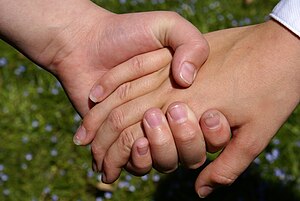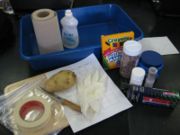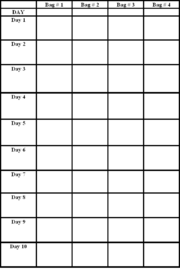Ew! Gross! Germs!
| Instant wiki maker | Making handouts | Editing tips |
Biology In Elementary Schools is a Saint Michael's College student project from a course that ran between 2007 and 2010 and fully described in this book chapter. The student-created resources have been preserved here for posterity. Link under 'toolbox' for printer-friendly versions of the exercises. Click on handouts to print full resolution versions. Please see Wikieducator's disclaimer, our safety statement, and the Creative Commons licensing in English and in legalese.
Student worthiness
This experiment was conducted with 12 groups of second grade studnets. It was very successful!
Primary biological content area covered
- Promotion of Proper Health
- Spread and Growth of Germs
Materials
Teacher and Student Use: (Fig. 1)
- Hand lotion
- Glitter
- Sink or large bucket
- Role of paper towels
- Soap
- Water (enough to wash hands with)
- Gloves (one pair per group)
- Potatoes (one per group)
- Sharp Knife
- Ziploc® Bags (four per group)
- Role of masking tape
- Marker for labeling
Handouts
We used one handout, which students used to record their observations. Each day, the students will describe what the four different potatoes look like. The students will be able to compare the amount of bacteria that grows on each potato, and therefore will determine which location in the classroom had the most germs. (Fig.2)
Description of activity
Students will learn about what a germ is, the different types (listed below) and how they spread. Students will also learn about proper health actions.
- Bacteria
- Viruses
- Fungi
- Protozoa
The students will first see how germs spread from person to person. The experiment begins by having the students apply lotion evenly to their hands. Students will then be given a small amount of glitter in one hand and will be instructed to move the glitter around in that one hand. Once the glitter has spread in one hand the students will put their hands together, and then shake hands with someone else in the classroom. They will then try to use a dry paper towel to remove the excess glitter and then again trying with water. Finally students will be asked to wash their hands with soap and water and realize that the only effective way to kill or wash away germs is by washing in soap and water.
Secondly, for this activity students will form a hypothesis regarding what will happen when the different germs, from around their classroom, grow in the potato. They will be instructed to hypothesize which germs will grow faster. The teacher or instructor will apply rubber gloves to their hands and using a knife will cut the students' group potatoes in four sections. Next the teacher will place a piece of masking tape on the bag, label it "control", and place a section of the potato in the bag. The teacher will then choose three places in the room to test for germs. With those places chosen, the students will rub one section of the potato on the sections. After rubbing the potato they will place it in the Ziploc bag and clearly label it. Once the bags have been completely filled, place them in a dark place, such as a cabinet, and let them sit for a week. After a week has passed the students should remove the bags from the cabinet. Finally, students will examine what happened in each bag and discover whether or not their educated guess was correct.
Lesson plan
Spreading Germs
- Ask the students what they know about germs as of now, and the ways in which germs spread from person to person. As they are answering the question, squeeze a dime-sized amount of hand-lotion in the palm of each student's hands and have them rub the lotion in so that it is spread evenly. (Fig. 3)
- Place a nickel-sized pile of glitter in the palm of your hand. We pretended to sneeze into our palms to demonstrate a way that these "germs" would have gotten onto our hands.
- Make a fist and move your fingers around. Be sure that the glitter is all over the palm of your hand.
- Put your hands together. Now, the glitter should be on both of your hands.(Fig. 4)
- Shake hands with the children in your group. What do you notice about their hand after you touch? Be sure that every student has some glitter on his or her hands. You may need to add more glitter to your own hands as you shake each students hand, depending on the number of students in the group. (Fig. 5)
- Once every student has glitter on his or her hands, se a dry paper towel to try and wipe of some of the glitter. What happens? There still should be a lot of glitter on each student's hands. (Fig. 6&7)
- Run the students hands under water. What happens? They still should have glitter on their hands. It helps to give an example, such as going to the bathroom and only rinsing your hands under the water. This way, the students will see that this does not eliminate all of the germs on their hands. (Fig. 8&9)
- Finally, have the students use soap and water to wash their hands. Have the children sing a song while washing their hands, such as Happy Birthday, to ensure that they scrub their hands long enough. Now, what has happened to the glitter? After the students have used soap and water and used a paper towel to dry off their hands, there should be no glitter left over.
- Emphasize to the students that the best way to remove as many germs as possible off of their hands is to wash with soap and water. (Fig.10,11,12)
- Students performing ''Spreading Germs'' experiment
Growing Germs
- Have an adult put on the rubber gloves. (Fig. 13)
- Using a knife, have the adult cut the potato into four sections. (Fig.14)
- Place a piece of masking tape on a Ziploc® bag. Label this bag "control" and put one section of the potato into it. (Fig.15)
- Pick three places in the room to use (ex: doorknob, desk top, pencil, computer keyboard).
- Rub one section of the potato on the first location. (Fig.16)
- Place it in a Ziploc® bag and label it. If there are more then one group performing the experiment, label each Ziploc® bag with their group number so that they can observe their own potatos.
- Repeat steps 5 and 6 two more times using the remaining two sections of the potato. Remember to label the Ziploc® bag so you know what you rubbed each section of the potato on. (Fig.17&18)
- Put the bags in a dark place, such as a cabinet. Leave them there for one week.
- When you are done, have an adult pour a little bleach into each bag and throw them away.
- Students performing ''Growing Germs'' experiment
Potential pitfalls
If you are not able to be near a sink, the first part of this experiment can be a challenge. We improvised with a basin in which we had the students put their hands over as we poured the water into it. Make sure to have plenty of soap and paper towels for the students when conducting this experiment!
Health connections
Germs are everywhere!
There are four common types of germs:
- Bacteria- tiny, one cell creatures that receive nutrients from their environments in order to live.
- Viruses- small living particles that can infect cells and impact how the cells function.
- Fungi- multicellular plant-like organisms that usually are not dangerous in a healthy person.
- Protozoa- one cell organisms that love moisture.
Most germs spread through the air by sneezes, coughs, or other bodily fluids.
How to avoid spreading germs in the classroom and at home:
- Washing your hands-It is extremely important to wash your hands after coughing, sneezing, using the bathroom, or blowing your nose. By using warm water and plenty of soap, you can eliminate the amount of germs that are on your hands. Scrub your hands for about 10 seconds or more with soap and then immerse them in the warm running water. It is essential to wash your hands before handling food. Remember to wash hands after petting an animal, changing a baby's dirty diaper, or working outside!
"Hand washing is the first line of defense against the spread of infectious diseases for adults as well as for children, according to the Centers for Disease Control and Prevention."
- Wipe down objects that students use in the classroom on a regular basis.
- Use antibacterial soap especially when cleaning faucets, doorknobs, and toys.
- Encourage students to cover their mouth when they cough or sneeze. If they cough or sneeze into their hands, make sure they thoroughly wash them with soap.
- Refrigerator doors, cookie jars, computer keyboards, faucets, and table tops are all examples of places where germs are likely to live and spread. Cleaning these areas in your home and classroom is beneficial for everyone's health. Avoid using multiple cleaning agents or chemical sprays on these objects.
Literature connections
- Cole, J. 1995. Magic School Bus Inside Ralphie: A Book about Germs. New York: Scholastic Inc.
- Katz, B. 1996. Germs! Germs! Germs!. New York: Scholastic Inc.
Connections to educational standards
S1-2:42 Students demonstrate their understanding of the Patterns of Human Health/Disease by…
- Identifying things in the environment that could be harmful if swallowed (e.g., soaps, cleaning solutions,
unknown pills).
Science Concepts: a. Some things people take into their bodies from the environment are toxic and can hurt them.
Next steps
<kaltura-widget kalturaid='8c5qorj44o' size='M' align='L'/>
As an additional means of demonstrating how germs spread, we did an experiment with "germ powder" and a black light. The germ powder is added to a teacher or instructors hands with a "germ powder" brush. This white powder exemplifies the everyday germ that people encounter. A teacher may shake hands with other students (we did this in our experiment). We were able to show the students that this white powder becomes almost impossible to notice on a persons hands. When the students do not notice the powder, turn on the black light and have the students place their hands underneath the light. The students will notice when they place their hand underneath the light that the places in which the powder is present has turned purple. you may continue to do this with each student. This proves to students that though we cannot see germs in our daily activities they are there. It is important to reiterate that after every activity we do and especially if we are sick we will be able destroy the germs by washing our hands with soap and water.
Reflections
Our Ew! Gross! Germs! experiment went really well! The students enjoyed each activity that we did. Although they did not care too much for the lotion on their hands, they had fun shaking hands and giving high-fives to one another with the glitter. I think that they learned the importance of washing their hands with soap and water. We even sang a song as we scrubbed our hands with soap to really make sure we got rid of all the germs. Overall, I think that the students' had fun while learning more about germs hands-on :)
-Megan
I believe our experiment went really well. The students seemed to really enjoy it. When we were leaving the school we found that most students were in the bathroom washing their hands while signing along to "Mary had a little lamb" or "Happy Birthday". It was really rewarding to hear the students singing. The students had a fun time shaking hands with each other and realizing that though we cannot readily see germs they are extremely present. They were able to understand that it is important to wash your hands with not only just water, but also with soap. I think the students had an extremely fun time learning about germs.
I agree with the other members of my group that our experiment went very well. We had an interesting activity that kept the students engaged for the duration of the session. By the end of the experiment, students had utilized the scientific method and made a hypothesis, determining which potato section would grow the most "germs". When asked what new information they learned, all of the students were able to respond with a unique and intriguing response. This was also evident in the thank you cards we received from them. All in all, I feel that the students learned a great deal about the spread of germs, how to best remove germs from their hands, and the locations in the classroom which generally receive the most traffic and therefore have the most germs. -Ashley
I really enjoyed doing this lesson with students. They seemed to really enjoy what we were teaching and they were engaged and interested for the entire twenty minutes. I also feel that the content was really important given the current take on germs and disease and the spread of other infections. This is a valuable lesson for students not just academically, but for everyday life as well. The only thing I would change would be the potato section. I would like there to have been a way for us to see the result of that portion of the experiment. It would have been beneficial for this experiement in the future if we could have seen the final product of the potatoes. Overall I think this was one of my favorite experiments to teach. - Colleen
Citations and links
http://www.hometrainingtools.com/articles/germ-science-projects-for-elementary.html
http://kidshealth.org/kid/talk/qa/germs.html
http://kidshealth.org/kid/stay_healthy/index.html
http://children.webmd.com/



















